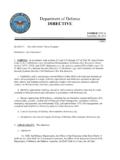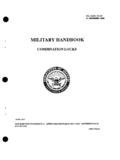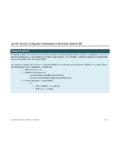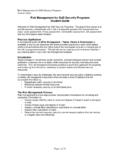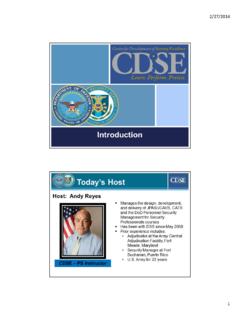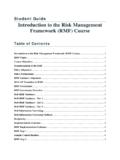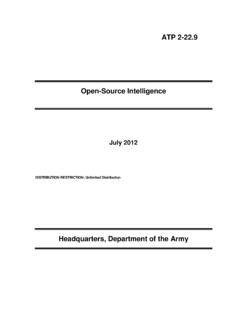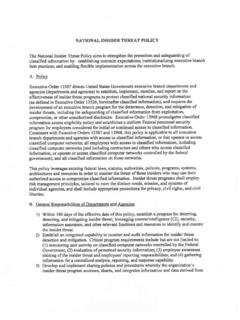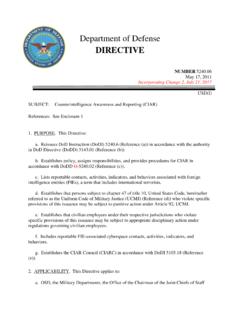Transcription of Integrating Counterintelligence and Threat Awareness into ...
1 Student Guide Course: Integrating Counterintelligence (CI) and Threat Awareness into Your Security Program, v2. Lesson: Course Introduction Contents Course Information 2. Course Overview 2. Course Objectives 3. Course Structure 3. Integrating CI and Threat Awareness into Your Security Program, v2 Student Guide Course Introduction Course Information Provide a thorough understanding of how Counterintelligence and Purpose Threat Awareness is an essential component of a security program Military, civilian, and contractor security professionals and practitioners Audience who develop and maintain security programs Pass/Fail % 75 percent Estimated 90 minutes completion time Course Overview In the espionage trade, many types of threats exist and many techniques are used to subtly extract information about personnel, their work, and colleagues. Pieces of information collected, classified or not, may be useful to an adversary.
2 By putting small pieces of information from various sources together, adversaries may be able to discover a level of detail that no one source would have been able to provide. Counterintelligence (CI) and Threat Awareness are fundamental and critical components for any successful security program. In this course, you will learn about incorporating CI. and Threat Awareness into your program. Page 2. Integrating CI and Threat Awareness into Your Security Program, v2 Student Guide Course Introduction Course Objectives Identify the purpose of incorporating Counterintelligence and Threat Awareness information into a security program Identify Counterintelligence and Threat Awareness policy requirements for Industry and DoD personnel Identify the role of the DSS Counterintelligence Directorate Identify the role of Threat identification in the analytical risk management process Identify key types of threats and common methods of operation Identify information most likely to be targeted by espionage Identify key sources of Threat information Identify the types of Counterintelligence and Threat Awareness information that should be reported Identify Counterintelligence and Threat information reporting requirements and procedures Course Structure Course Introduction Introduction to Counterintelligence and
3 Threat Awareness Identifying threats Obtaining Counterintelligence and Threat Information Reporting Counterintelligence and Threat Information Course Conclusion Page 3. Student Guide Course: Integrating Counterintelligence (CI) and Threat Awareness into Your Security Program, v2. Lesson 2: Introduction to Counterintelligence (CI) and Threat Awareness Contents Introduction 2. Why Counterintelligence (CI) and Threat Awareness ? 2. Regulatory Basis 3. DSS Counterintelligence (CI) Directorate 4. Review Activity 1 5. Review Activity 2 5. Lesson Conclusion 6. Answer Key 7. Review Activity 1 7. Review Activity 2 7. Integrating CI and Threat Awareness into Your Security Program, v2 Student Guide Introduction to Counterintelligence and Threat Awareness Introduction Objectives A security program cannot succeed without Counterintelligence (CI) and Threat Awareness .
4 The cost of failure cannot be measured. This lesson shows why CI and Threat Awareness are important, and helps identify requirements that must be satisfied. Lesson objectives are: Identify the purpose of incorporating CI and Threat Awareness information in a security program Identify CI and Threat Awareness policy requirements for Industry and DoD. personnel Identify the role of the Defense Security Service (DSS) Counterintelligence (CI). Directorate Why Counterintelligence (CI) and Threat Awareness ? Evolution of Counterintelligence (CI). Since our country's infancy, the Threat of espionage and the damage it could inflict has been real. Government and military leaders have always been concerned with such threats . In the aftermath of World War II, President Truman signed into law the National Security Act of 1947. The act addresses CI and created the National Security Council and the Central Intelligence Agency.
5 In 1981, President Reagan issued Executive Order 12333, United States Intelligence Activities, which regulates the collection of intelligence information, as well as outlines responsibilities of and cooperation between members of the national intelligence community. Today, EO 12333 continues to shape the practice of CI, which includes . according to the National Counterintelligence Strategy of the defensive and offensive activities conducted at home and abroad to protect against the traditional and emerging foreign intelligence threats of the 21st century. Over time, as adversaries changed and technological advances grew exponentially, so did the scope of threats from espionage. Today, the types of threats , methods of operation, and their targets cast a wider net than ever. Not only must we remain vigilant for the sake of our national security, but we also must protect trade secrets and the competitive advantage that companies and in turn, the economy rely on.
6 As a security official, when you integrate CI and Threat Awareness into your security program, not only are you protecting the way of life for your country and the lives of its warfighters but you are also protecting your organization, your livelihood, and the livelihood of your co-workers. Just as national security depends on you, so does the ability of companies to survive and compete in the world economy. Simply put, the workforce maybe even your employment depends on you. Page 2. Integrating CI and Threat Awareness into Your Security Program, v2 Student Guide Introduction to Counterintelligence and Threat Awareness What is Counterintelligence (CI)? In order to integrate Counterintelligence and Threat Awareness information into a security program, you need a strong understanding of what Counterintelligence is and what it should achieve. Executive Order 12333 defines Counterintelligence as information gathered and activities conducted to identify, deceive, exploit, disrupt, or protect against espionage, other intelligence activities, sabotage, or assassinations conducted for or on behalf of foreign powers, organizations or persons, or their agents, or international terrorist organizations or activities.
7 Using real-time Threat Awareness information for countering the Threat to classified programs, secrets, technologies, and operations enables the Government to better protect technology and operations. This allows the United States to: Maintain a strategic advantage Assist in force protection Provide security Awareness tools for establishing security countermeasures Ensure the integrity of DoD and industry program secrets, technologies, and operations Protect the lives of our warfighters Regulatory Basis Counterintelligence (CI) Requirements Executive Order 12333 provides the legal requirement to use all reasonable and lawful means to ensure that the United States receives the best intelligence available. CI is part of this requirement. In addition, the EO 12333 requires intelligence activities to ensure the protection of persons' rights while employing the least intrusive means when collecting information.
8 DoD has implemented this requirement in two regulations: 1. DoD , Volume 1, Enclosure 3, the DoD Information Security Program, outlines required security education and training as well as procedures for addressing compromised classified information. 2. DoD Directive , the Insider Threat Program, includes requirements for continuing security education and reporting requirements. In addition, DoD Directive , Counterintelligence Awareness and Reporting (CIAR), provides further guidance. Requirements for the intelligence community (IC) are contained in two directives: 1. Intelligence Community Directive (ICD) 700 establishes IC policy for the protection of national intelligence. It provides a framework for greater coordination and communications between Counterintelligence and security Page 3. Integrating CI and Threat Awareness into Your Security Program, v2 Student Guide Introduction to Counterintelligence and Threat Awareness activities of the IC to strengthen the ability to identify, deter, disrupt, mitigate, and counteract intelligence activities directed against interests by foreign powers or activities.
9 2. ICD 750 establishes the baseline for Counterintelligence programs across the IC. to create a strategic approach to Counterintelligence that will enhance the national security posture of the The ICD 750 recommends Counterintelligence to be functionally integrated with security programs per the ICD 700. Special requirements for contractors are provided in DoD , the National Industrial Security Program Operating Manual (NISPOM.). DSS Counterintelligence (CI) Directorate Role of the DSS Counterintelligence (CI) Directorate The DSS Counterintelligence (CI) Directorate provides CI support to cleared Defense contractors. This support includes identifying, exploiting, and neutralizing espionage and collection attempts by foreign intelligence and security services. As a security official, the DSS CI Directorate is a central CI source for you and your organization.
10 If you are a facility security officer (FSO) at a cleared contractor facility, the DSS CI Directorate is one of your primary sources of information. If you are a military member or civilian Government employee, information from this office may supplement what you receive through your chain of command from your designated CI support activity. The DSS CI Directorate provides early detection and referral of potential espionage cases to applicable CI community and law enforcement entities. The office assists industry in the recognition and reporting of collection attempts by foreign nation state intelligence and non-nation state actors. As part of this role, the office publishes Threat information annually and makes it available to cleared contractors. The DSS CI. Directorate also helps develop countermeasures and advises industry on their application.
